Family name: Aponogetonaceae J. Agardh
Synonym(s): [none]
Common name(s): cape pondweed family
*Number of genera/species: 1/56
seed
Fruit a folliclefollicle:
a dry to (rarely) fleshy fruit derived from a single carpel that opens along a single longitudinal suture, derived from a single, superior, simple ovary; the seeds may be arillate or with a fleshy testa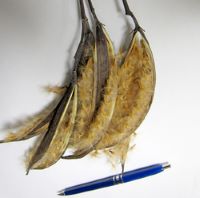 , which are free or nearly free from each other, 2–22 mm long, globoseglobose:
, which are free or nearly free from each other, 2–22 mm long, globoseglobose:
3D shape—more or less spherical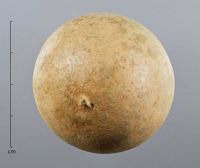 to teardrop shapedteardrop-shaped:
to teardrop shapedteardrop-shaped:
2D shape—widest point is toward one end of the fruit, the other end tapers sharply to a pointed end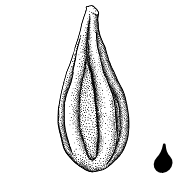 , tereteterete:
, tereteterete:
approximately circular in cross section; width and thickness approximately equal
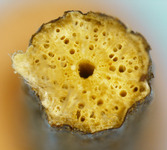 in transection, beaks distinct and often curvedcurved:
in transection, beaks distinct and often curvedcurved:
(of embryo) linear embryo is curved into an arch or horseshoe with the ends far apart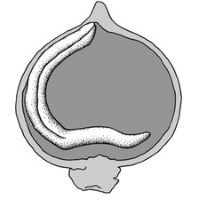 , with one to many seeds. Pericarp brown to green, leatheryleathery:
, with one to many seeds. Pericarp brown to green, leatheryleathery:
texture—moderately thick, tough, and very pliable
, and decaying at maturity to release seeds. The infructescencesinfructescence:
mature (fruiting) inflorescence
often form underwater.
Seeds cylindricalcylindrical:
3D shape—a cylinder, with parallel sides and a circular cross-section; tubular or rod-shaped
to lens-shapedlens-shaped:
2D shape—round and flattened with two curved (convex) surfaces
, 0.7–18 mm long. Two seed types are present, double-coated seeds with sarcotestassarcotesta:
pulpy or fleshy outer layer of the seed coat, simulates aril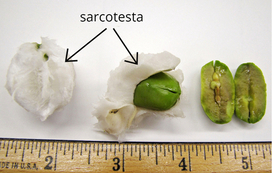 or single-coated. In double-coated seeds, the outer layer is transparent (loose and mucilaginousmucilaginous:
or single-coated. In double-coated seeds, the outer layer is transparent (loose and mucilaginousmucilaginous:
resembling mucilage; moist and sticky
) and veined, and the inner layer is brown. Embryos are not well developed in the double-coated seeds. In single-coated seeds, the seed coat is brown to green, glossyglossy:
shiny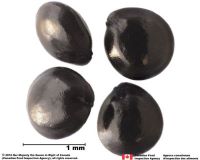 , thick and spongyspongy:
, thick and spongyspongy:
soft, light, discontinuous but cohesive, and somewhat resilient
, and smooth, wrinkledwrinkled:
surface relief—shallow, irregular folds and furrows covering the surface; appearing overall though crumpled and then spread out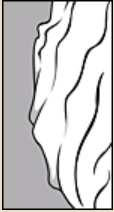 , or longitudinally ribbedribbed:
, or longitudinally ribbedribbed:
surface relief—wide, prominent, linear ridges that are generally rounded and longitudinally situated on the surface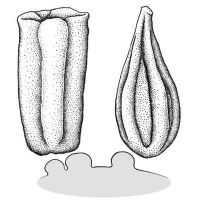 . The embryo is well developed.
. The embryo is well developed.
Embryo straight, linearlinear:
(shape) long, narrow, and uniform in width; (of embryo) embryo is straight and much longer than wide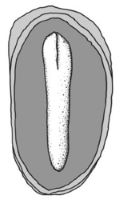 , sometimes green in single-coated seeds.
, sometimes green in single-coated seeds.
Endosperm lacking.
Aquatic plants, occurring in stagnant to fast-moving water. Usually not weedy, but Aponogeton distachyos L.f., is established in Australia and occurs in central-coastal and southern California.
Aquarium & Pond Plants of the World tool includes descriptions and images of genera in this family.
| Fruit | |
| Type | folliclefollicle: a dry to (rarely) fleshy fruit derived from a single carpel that opens along a single longitudinal suture, derived from a single, superior, simple ovary; the seeds may be arillate or with a fleshy testa  |
| Size range | 2–22 mm long (includes beakbeak: a usually firm, terminal appendage, sometimes tapered 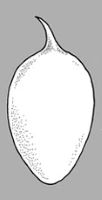 ) ) |
| Shape(s) | teardrop-shapedteardrop-shaped: 2D shape—widest point is toward one end of the fruit, the other end tapers sharply to a pointed end  , oblongoblong: , oblongoblong:2D shape—much longer than broad with nearly parallel sides, corners are rounded 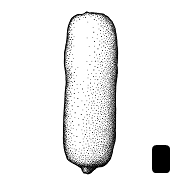 , globoseglobose: , globoseglobose:3D shape—more or less spherical  |
| Texture | leatheryleathery: texture—moderately thick, tough, and very pliable |
| Surface relief | smooth |
| Color(s) | reddish brown, green, brown, gray |
| Unique features | Small, leatheryleathery: texture—moderately thick, tough, and very pliable , folliclesfollicle: a dry to (rarely) fleshy fruit derived from a single carpel that opens along a single longitudinal suture, derived from a single, superior, simple ovary; the seeds may be arillate or with a fleshy testa  with beaks, which may be short or long, terminal or laterallateral: with beaks, which may be short or long, terminal or laterallateral:(of embryo) embryo lies along the side of the seed, generally towards one end; of, at, or from the side; in grasses, can refer to the sides adjacent to the dorsal and ventral sides , and straight or curvedcurved: (of embryo) linear embryo is curved into an arch or horseshoe with the ends far apart  |
| Seed | |
| Size range | 0.7–18 mm long |
| Shape(s) | oblongoblong: 2D shape—much longer than broad with nearly parallel sides, corners are rounded  , cylindricalcylindrical: , cylindricalcylindrical:3D shape—a cylinder, with parallel sides and a circular cross-section; tubular or rod-shaped , ellipsoidellipsoid: 3D shape—elliptic , lens-shapedlens-shaped: 2D shape—round and flattened with two curved (convex) surfaces , fusiformfusiform: spindle-shaped; broadest at the middle and tapering at both ends 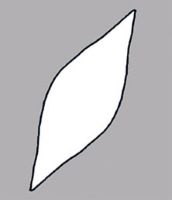 |
| Surface relief | smooth, wrinkledwrinkled: surface relief—shallow, irregular folds and furrows covering the surface; appearing overall though crumpled and then spread out  , or ribbedribbed: , or ribbedribbed:surface relief—wide, prominent, linear ridges that are generally rounded and longitudinally situated on the surface  |
| Color(s) | brown, purple, green, gray |
| Other | |
| Embryo | rudimentaryrudimentary: (of embryo) embryo is small and fills less than a quarter of the seed and can be variable in shapes, such as linear, spatulate, or oval 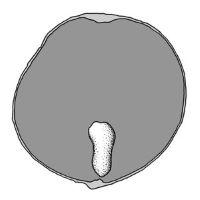 or moderately well developed or moderately well developed |
| Nutritive tissue | lacking at maturity |
Tropical and subtropical regions in Africa, Madagascar, Asia, and Australia.
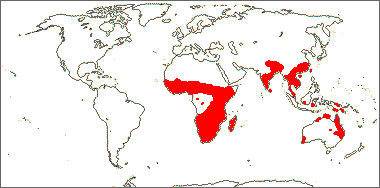
Distribution map courtesy of Angiosperm Phylogeny Website.
Baskin and Baskin 2021Baskin and Baskin 2021:
Baskin C and Baskin J. 2021. Relationship of the lateral embryo (in grasses) to other monocot embryos: A status up-grade. Seed Science Research 31 (3): 199-210. doi:10.1017/S0960258521000209; Dahlgren et al. 1985Dahlgren et al. 1985:
Dahlgren RMT, Clifford HT, and Yeo PF. 1985. The families of the monocotyledons: structure, evolution, and taxonomy. Springer-Verlag, Berlin. 520 pp.; Flora of Australia 2021+Flora of Australia 2021+:
Flora of Australia. Australian Biological Resources Study, Canberra. Accessed January 2021–March 2024. URL: http://www.ausflora.org.au; Kirkbride et al. 2006Kirkbride et al. 2006:
Kirkbride JH, Jr, Gunn CR, and Dallwitz MJ. 2006. Family guide for fruits and seeds, vers. 1.0. Accessed September 2020-January 2022. URL: https://nt.ars-grin.gov/seedsfruits/keys/frsdfam/index.cfm .; Kubitzki et al. 1990+Kubitzki et al. 1990+:
Kubitzki K et al., eds. 1990+. The families and genera of vascular plants. 7+ vols. Berlin etc.; Lye 1989aLye 1989a:
Lye KA. 1989. Aponogetonaceae. In: Polhill RM, ed. Flora of Tropical East Africa. AA Balkema, Rotterdam, Netherlands. 10 pp.; Thiselton-Dyer 1897Thiselton-Dyer 1897:
Thiselton-Dyer WT. 1897. Flora capensis: being a systematic description of the plants of the Cape colony, Caffraria, amp; Port Natal (and neighbouring territories). Vol. 7. L. Reeve, Kent UK. 791 pp. https://doi.org/10.5962/bhl.title.821; van Bruggen 1969van Bruggen 1969:
van Bruggen HWE. 1969. Revision of the genus Aponogeton (Aponogetonaceae). Blumea 16 (1): 143-265.; van Bruggen 1973van Bruggen 1973:
van Bruggen HWE. 1973. Revision of the genus Aponogeton (Aponogetonaceae) VI. The species of Africa. Bulletin du Jardin Botanique National de Belgique/ Bulletin van de Nationale Plantentuin van Belgie 43: 193-233. https://doi.org/10.2307/3667566; Watson and Dallwitz 1992+Watson and Dallwitz 1992+:
Watson L and Dallwitz MJ. 1992+. The families of flowering plants: descriptions, illustrations, identification, and information retrieval. Version: 6th Accessed September 2020-September 2022. URL: delta-intkey.com
*The number of genera and species is based on Christenhusz and Byng 2016Christenhusz and Byng 2016:
Christenhusz MJM and Byng JW. 2016. The number of known plant species in the world and its annual increase. Phytotaxa 261 (3): 201-217. https://doi.org/10.11646/phytotaxa.261.3.1, which may differ from the number of genera in GRIN-Global.